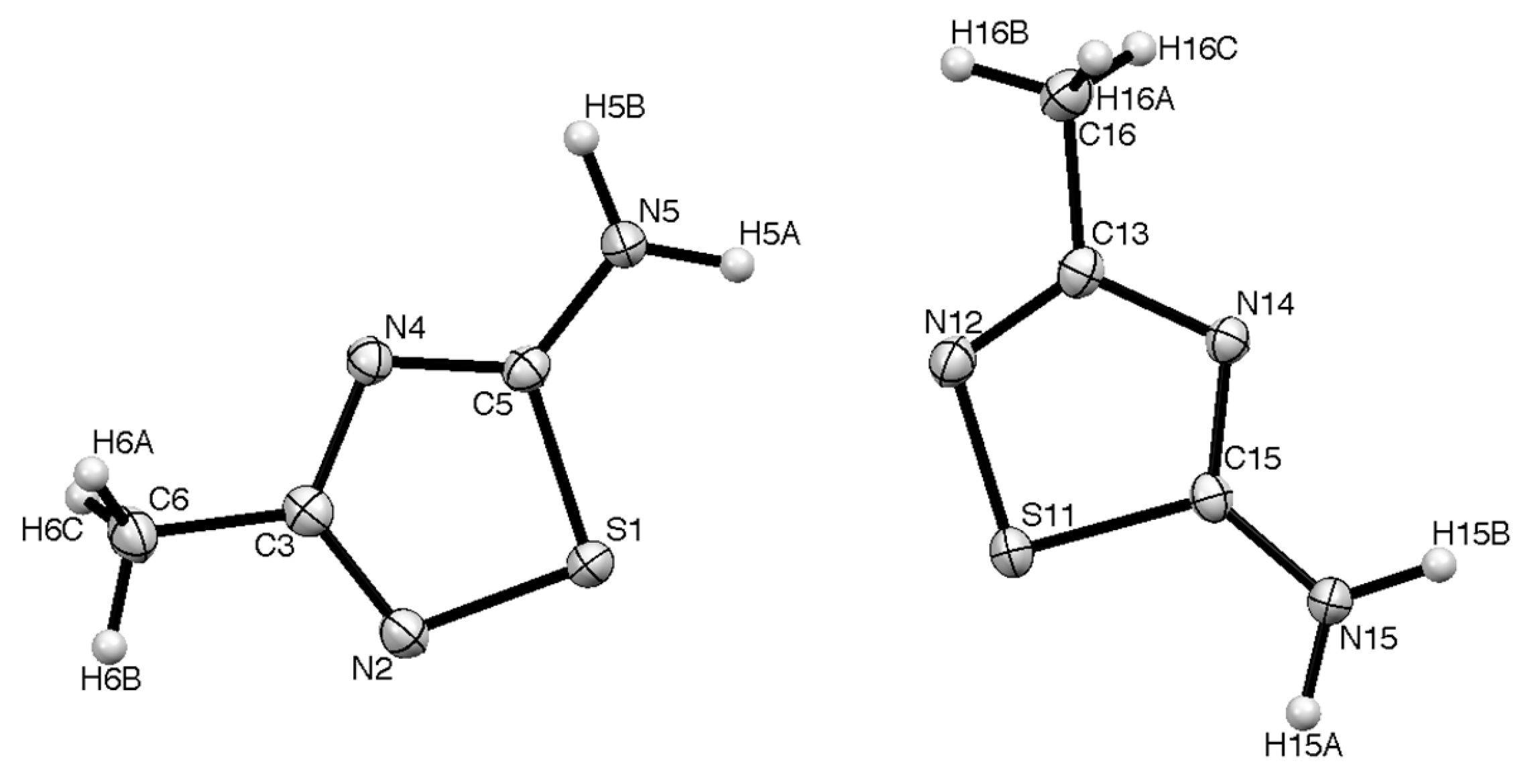5-Amino-3-methyl-1,2,4-thiadiazole
Abstract
:1. Introduction
2. Results
3. Experimental
5-Amino-3-methyl-1,2,4-thiadiazole (1)
Supplementary Materials
Author Contributions
Conflicts of Interest
References
- Goerdeler, J. Über 1.2.4-Thiodiazole, 1. Mitteil.): Darstellung und Eigenschaften der 5-amino-1.2.4-thiodiazole. Eur. J. Inorg. Chem. 1954, 87, 57–67. [Google Scholar] [CrossRef]
- Zbirovsky, M.; Puncochar, L.; Stanek, J.; Zemanek, J. 1,2,4-Thiadiazole Pesticides. Czechoslovak Patent CS 120541, 15 November 1966. [Google Scholar]
- Marrano, C.; de Macédo, P.; Gagnon, P.; Lapierre, D.; Gravel, C.; Keillor, J.W. Synthesis and Evaluation of Novel Dipeptide-Bound 1,2,4-Thiadiazoles as Irreversible Inhibitors of Guinea Pig Liver Transglutaminase. Bioorg. Med. Chem. 2001, 9, 3231–3241. [Google Scholar] [CrossRef]
- Ishiwata, Y. Azo Dye and Azo Compound. European Patent EP 1975204 A2, 1 October 2008. [Google Scholar]
- Cho, Y.L.; Heo, H.J.; Oh, K.M.; Lee, H.S.; Park, C.S.; Chae, S.E.; Yun, J.Y.; Kwon, H.J.; Yang, Y.J.; Kang, D.H.; et al. Novel Cephalosporin Derivatives and Pharmaceutical Composition Thereof. U.S. Patent 20120264727 A1, 18 October 2012. [Google Scholar]
- Cho, Y.L.; Yun, J.Y.; Park, C.S.; Chae, S.E.; Lee, H.S.; Oh, K.; Heo, H.J.; Kang, D.H.; Yang, Y.J.; Kwon, H.J.; et al. Novel Cephalosporin Derivative and Pharmaceutical Composition Thereof. European Patent EP 2706062 A2, 12 March 2014. [Google Scholar]
- Dox, A.W. Acetamidine hydrochloride. Org. Synth. 1932, 1, 5–6. [Google Scholar] [CrossRef]
- Miller, A.H.; Pancirov, R.J. Mass spectra I. Mass spectra of 1,2,4-thiadiazoles. J. Heterocycl. Chem. 1971, 8, 163–166. [Google Scholar] [CrossRef]
- Inagaki, T.; Kurita, Y.; Akihito, M.; Kondo, M. Method for Preparing 5-Amino-1,2,4-Thiadiazol Acetic Acid Derivatives. U.S. Patent 5,773,624, 30 June 1998. [Google Scholar]
- Bowman, W.R.; Burchell, C.J.; Kilian, P.; Slawin, A.M.Z.; Wormald, P.; Woollins, J.D. Investigations on organo-sulfur-nitrogen rings and the thiocyanogen polymer, (SCN)x. Chem. Eur. J. 2006, 12, 6366–6381. [Google Scholar] [CrossRef] [PubMed]
- Cho, N.S.; Kim, Y.H.; Park, M.S.; Kim, E.H.; Kang, S.K.; Park, C. Oxidative cyclization of dithiobiuret under basic conditions and theoretical tautomeric studies of 5-amino-2,3-dihydro-1,2,4-thiadiazole-3-thione. Heterocycles 2003, 60, 1401–1409. [Google Scholar] [CrossRef]
- Holynska, M.; Kubiak, M. Products of the oxidation of 1-(diaminomethylene)thiourea with hydrogen peroxide. Acta Crystallogr. Sect. C 2008, 64, 609–612. [Google Scholar] [CrossRef] [PubMed]



| D-H···A | D-H | H···A | D···A | D-H···A |
|---|---|---|---|---|
| N(5)-H(5A) ···N(12) | 2.014(13) | 0.972(15) | 2.962(2) | 164.5(17) |
| N(5)-H(5B) ···N(4) | 2.013(10) | 0.973(11) | 2.978(2) | 171.1(15) |
| N(15)-N(15A) ···N(2) | 2.006(17) | 0.973(16) | 2.975(2) | 173.3(16) |
| N(15)-N(15B) ···N(14) | 2.020(20) | 0.972(19) | 2.992(2) | 173.2(12) |
© 2018 by the authors. Licensee MDPI, Basel, Switzerland. This article is an open access article distributed under the terms and conditions of the Creative Commons Attribution (CC BY) license (http://creativecommons.org/licenses/by/4.0/).
Share and Cite
Aitken, R.A.; Slawin, A.M.Z. 5-Amino-3-methyl-1,2,4-thiadiazole. Molbank 2018, 2018, M977. https://doi.org/10.3390/M977
Aitken RA, Slawin AMZ. 5-Amino-3-methyl-1,2,4-thiadiazole. Molbank. 2018; 2018(1):M977. https://doi.org/10.3390/M977
Chicago/Turabian StyleAitken, R. Alan, and Alexandra M. Z. Slawin. 2018. "5-Amino-3-methyl-1,2,4-thiadiazole" Molbank 2018, no. 1: M977. https://doi.org/10.3390/M977







